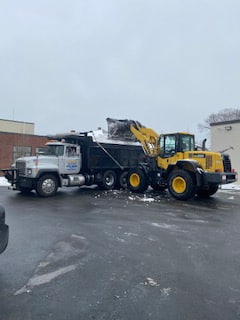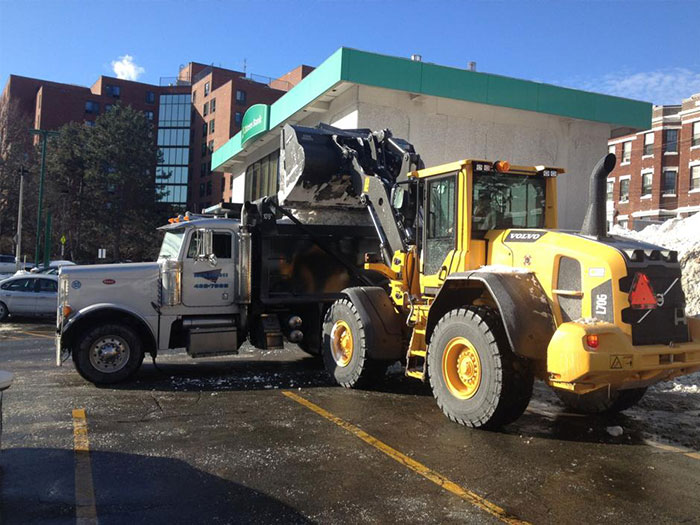Commercial Roof Snow Removal: Top Methods for 2024 Safety
Why Commercial Roof Snow Removal Matters
Commercial roof snow removal is essential for maintaining the safety and integrity of your building during winter. For a quick answer: It’s vital because accumulated snow can be extremely heavy, leading to structural damage, leaks, and even roof collapses if not properly managed.
Key Points:
- Maximum Load Limits: Every roof has a maximum weight it can safely support.
- Snow Weight: Dry snow can weigh around 7 lbs per cubic foot; wet snow can range from 12 to 18 lbs per cubic foot.
- Safety Hazards: Accumulated snow can lead to avalanches, leaks, and collapses that endanger your employees and customers.
Snow accumulation on a flat roof can be more problematic due to the sheer volume that can build up, leading to thousands of pounds of stress. Ignoring this issue can result in major building damage and severe safety hazards. Even a few inches of snow can exceed the load limit of most commercial roofs, making timely snow removal crucial.
Problems Caused by Snow Accumulation:
- Structural Damage
- Roof Leaks
- Safety Risks
- Loss of Productivity
During winter, a flat roof can collect several feet of snow, adding immense pressure on the structure. Without removing this snow, you’re putting your building at risk of significant damage, which can be costly to repair. Using professional services ensures the job is done safely and correctly, preventing damage to your roof and keeping your property accessible and safe.
By staying prepared and taking action early, you can protect your commercial property from the severe effects of snow accumulation. Read on to learn more about the importance of snow removal, effective methods, and how to keep your roof safe during the winter months.
Learn more about commercial roof snow removal:
– commercial snow removal contract
– commercial snow removal near me
– snow removal service
Why is Commercial Roof Snow Removal Important?
Commercial roof snow removal is not just a winter chore; it’s a critical task to ensure the safety and longevity of your building. Let’s break down why this is so important.
Weight Limits and Roof Collapse
Every roof has a maximum load limit, which is the total weight it can safely support. Exceeding this limit can lead to catastrophic consequences. For instance:
- Dry snow weighs about 7 lbs per cubic foot.
- Wet snow can weigh between 12 to 18 lbs per cubic foot.
Even a moderate snowfall can quickly add up to thousands of pounds on your roof. If your roof’s load limit is exceeded, it can lead to a roof collapse, causing extensive damage and posing serious risks to anyone inside the building.
Building Damage
Snow accumulation can cause several types of damage to your building, including:
- Structural Damage: The weight of the snow can weaken the roof’s structure, leading to cracks and eventual collapse.
- Roof Leaks: Melting snow can seep into cracks and cause leaks, damaging the interior of your building.
- Blocked Drains and Gutters: Snow and ice can clog drainage systems, leading to water buildup and potential flooding.
Safety Hazards
Accumulated snow on your roof can create dangerous conditions:
- Roof Avalanches: Large amounts of snow can suddenly slide off the roof, endangering anyone below.
- Falls and Injuries: If employees attempt to remove snow themselves, they risk falling or getting injured.
- Electrical Hazards: Snow removal can lead to accidental contact with power lines, posing electrocution risks.
Productivity Loss
A damaged or unsafe building can severely impact your business operations:
- Emergency Repairs: Unexpected roof repairs can be costly and time-consuming.
- Business Disruption: Safety hazards may force you to close your building temporarily, leading to loss of productivity and revenue.
- Employee Safety: Ensuring a safe working environment is crucial for maintaining employee morale and efficiency.
By understanding the importance of commercial roof snow removal, you can take proactive steps to protect your property and ensure the safety of everyone inside.
Next, we’ll explore the different methods for removing snow from commercial roofs, including the tools and services that can help you get the job done safely and effectively.
Methods for Removing Snow from Commercial Roofs
Using a Roof Rake
A roof rake is one of the simplest tools for commercial roof snow removal. It consists of a long telescoping handle with a blade at the end, often made from a rubber squeegee to prevent damage to the roof surface.
Steps to Use a Roof Rake:
1. Assemble the Roof Rake: Attach the blade to the telescoping handle.
2. Position the Rake: Stand safely on the ground and extend the rake to the edge of the roof.
3. Pull Snow Down: Gently pull the rake towards you to remove the snow. Leave about an inch of snow to avoid scraping the roof surface.
Benefits:
– Safety: You can remove snow without getting on the roof.
– Cost-Effective: Roof rakes are relatively inexpensive.
– Minimal Damage: The rubber squeegee blade reduces the risk of damaging the roof.
Professional Snow Removal Services
Hiring licensed professionals for snow removal ensures the job is done safely and efficiently. Companies like Marchi Paving Inc. offer comprehensive services that include snow and ice removal, ensuring your roof remains in optimal condition throughout winter.
What Professionals Offer:
– Safety Measures: Professionals use safety equipment like harnesses and fall protection to prevent accidents.
– Specialized Equipment: They employ tools such as steamers and eco-friendly ice melters to remove snow and ice without damaging the roof.
– Expertise: Licensed professionals follow safety regulations and have the experience to spot potential issues.
Case Study:
One of our clients faced severe snow accumulation on their flat roof, risking a collapse. Our team quickly intervened, using steamers to melt the snow and clear the drainage systems. The process was completed without any damage to the roof, saving the client from costly repairs.
Manual Snow Shoveling
Manual shoveling is another method, but it requires caution to avoid damaging the roof or causing injuries.
Steps for Safe Shoveling:
1. Use Plastic-Bladed Shovels: Metal blades can damage the roof surface. Plastic blades are safer.
2. Clear in Sections: Remove snow in small sections to avoid overloading any part of the roof.
3. Work in Pairs: One person can shovel while the other ensures safety and assists if needed.
Safety Precautions:
– Avoid Heavy Loads: Shoveling heavy, wet snow can weaken roof supports.
– Watch Your Step: Be mindful of skylights, vents, and other rooftop features.
– Dress Warmly: Wear layers to prevent hypothermia.
Quote:
By understanding and utilizing these methods, you can effectively manage snow removal on your commercial roof and maintain the safety and integrity of your building.
Next, we’ll discuss when snow should be removed from a commercial roof to prevent damage and ensure safety.
When Should Snow Be Removed from a Commercial Roof?
Knowing when to remove snow from a commercial roof is crucial to prevent damage and ensure safety. Here are some key points to consider:
Snow Load Limits
Every roof has a maximum load limit, which is the amount of weight it can safely support. This limit can be exceeded with as little as 6 inches of wet snow. Wet snow can weigh between 12 to 18 lbs. per cubic foot, while dry snow weighs around 7 lbs. per cubic foot. It’s essential to monitor snow accumulation and its weight to avoid overloading the roof.
Weight of Snow
Understanding the weight of snow is important. A cubic foot of dry snow weighs about 7 lbs., but wet snow can be much heavier. For instance, 12 inches of wet snow can add thousands of pounds of stress to your roof. Always consider the type of snow when assessing the need for removal.
FEMA Guidelines
FEMA suggests looking for certain signs to determine if the weight of snow is too much for your roof:
- Sagging ceiling tiles or boards
- Popping, cracking, and creaking noises
- Sagging roof members, including metal decking or plywood sheathing
- Bowing truss bottom chords or web members
- Doors and windows that can no longer be opened or closed
- Cracks in walls or masonry
- Severe roof leaks
If you notice any of these signs, it’s time to remove the snow immediately.
Warning Signs of Stress
Be vigilant for signs that your roof is under stress from snow accumulation. These can include:
- Visible sagging: Check for sagging in the roof structure or ceiling.
- Unusual sounds: Listen for creaking, cracking, or popping noises.
- Water leaks: Look for new leaks or water stains on the ceilings and walls.
- Structural changes: Notice if doors or windows become difficult to open or close.
Timely Snow Removal
Typically, you should start removing snow when it reaches 50% of your roof’s load capacity. For many roofs, this could mean removing snow when it’s just 6 inches deep, especially if it’s wet snow. Don’t wait for signs of imminent collapse; proactive removal is key.
By keeping these guidelines in mind, you can ensure that snow is removed from your commercial roof at the right time, preventing damage and maintaining safety.
Next, we’ll explore how to prepare for snowy weather to avoid potential roofing disasters.
Preparing for Snowy Weather
When it comes to commercial roof snow removal, preparation is key. By taking proactive steps before the snow arrives, you can prevent damage and ensure the safety of your building. Here are some essential preparation tips:
Preventive Maintenance
Start with preventive maintenance. This means inspecting your roof for any signs of damage, clogged gutters, or debris. A well-maintained roof is less likely to suffer from snow-related issues. Address any repairs needed before the snow season begins.
Roof Inspection
Conduct a thorough roof inspection. Check for weak spots, leaks, or structural damage. Focus on areas around HVAC units, skylights, and other roof penetrations. Identifying and fixing these problems early can save you from bigger headaches later.
Wind Baffles
Consider installing wind baffles. These devices help to reduce wind pressure on your roof, preventing snow from accumulating in drifts. Wind baffles can be particularly useful in areas with high winds and heavy snowfall.
Snow Guards
Snow guards are another effective tool. They hold the snow in place, preventing it from sliding off in large chunks. This not only protects your roof but also ensures the safety of people and property below.
Roof Map
Create a detailed roof map. This map should identify all roof features, such as drains, gutters, HVAC units, and skylights. A roof map helps in planning snow removal and ensures that no critical areas are missed during the process.
By following these preparation tips, you can minimize the risks associated with snow accumulation on your commercial roof. Proper preparation not only protects your building but also ensures the safety of everyone inside.
Next, we’ll discuss the safety measures during snow removal to keep your team and property safe during the process.
Safety Measures During Snow Removal
Safety is paramount when it comes to commercial roof snow removal. The risks involved can lead to severe injury or even death if not properly managed. Here are essential safety measures to ensure a safe snow removal process:
Fall Protection
Falls are one of the most significant hazards during snow removal. To prevent falls:
- Use Harnesses and Guardrails: Ensure all workers are equipped with safety harnesses and secure guardrails around the work area.
- Install Warning Lines: These lines help to demarcate safe zones and keep workers away from roof edges.
- Training: Workers should be trained in the proper use of fall protection equipment.
OSHA Regulations
Compliance with OSHA regulations is not just about avoiding fines; it’s about keeping your team safe. OSHA mandates:
- Proper Fall Protection: Any worker on a roof must have appropriate fall protection in place.
- Equipment Maintenance: Regularly inspect and maintain all safety equipment to ensure it’s in good working order.
- Documentation: Keep records of all safety training and equipment inspections.
Hypothermia Prevention
Working in cold conditions poses the risk of hypothermia. To prevent this:
- Wear Appropriate Clothing: Dress in layers, including thermal undergarments, waterproof outer layers, and insulated gloves and boots.
- Take Breaks: Schedule regular breaks in a warm area to prevent prolonged exposure to cold.
- Stay Hydrated: Drinking warm, non-caffeinated beverages can help maintain body temperature.
Safe Snow Storage
Properly managing where the snow goes after removal is crucial:
- Designate Dump Zones: Identify safe areas away from buildings, walkways, and essential infrastructure to dump the snow.
- Avoid Blocking Exits: Ensure that snow piles do not block emergency exits or pathways.
- Monitor Snow Piles: Keep an eye on snow piles for potential refreezing and ice formation, which can create hazards later.
By adhering to these safety measures, you can significantly reduce the risks associated with commercial roof snow removal. Prioritizing safety not only protects your team but also ensures the integrity of your roof and building.
Next, we’ll address some frequently asked questions about commercial roof snow removal to clarify common concerns and provide further guidance.
Frequently Asked Questions about Commercial Roof Snow Removal
How do professionals remove snow from roofs?
Professionals use a variety of methods to safely and effectively remove snow from commercial roofs.
Roof Rake: This tool features a telescoping handle and a rubber squeegee blade, allowing workers to pull snow off the roof without stepping on it. This minimizes the risk of roof damage and personal injury.
Professional Services: Hiring licensed professionals ensures the job is done safely and efficiently. They come equipped with specialized tools and safety gear, such as fall protection harnesses and guardrails, to handle the task without endangering themselves or damaging your roof.
Safety Equipment: Professionals use safety equipment like harnesses, guardrails, and warning lines to prevent falls. They also follow OSHA regulations to ensure a safe working environment.
Should snow on a roof be removed?
Yes, snow should be removed from commercial roofs to prevent several hazards:
Weight Limits: Every roof has a maximum load limit. Exceeding this limit can lead to a roof collapse. Wet snow can be particularly heavy, weighing up to 18 lbs. per cubic foot.
Water Damage: Accumulated snow can melt and refreeze, creating ice dams. These dams block drainage, leading to water leaks and potential damage to the building’s interior.
Roof Collapse: Ignoring snow buildup can result in severe structural damage or even a complete roof collapse, endangering employees and inventory.
How do you remove snow from a high roof?
Removing snow from a high commercial roof requires specialized tools and precautions:
Roof Rake: A roof rake with a telescoping handle can be used to reach higher areas from the ground or a safe platform. This method minimizes the need for workers to climb onto the roof.
Professional Services: For high roofs, it’s best to hire professionals. They have the necessary equipment, such as aerial lifts and safety harnesses, to safely access and clear snow from liftd areas.
Safety Equipment: Ensuring the use of proper safety gear, like harnesses and guardrails, is crucial. Professionals are trained to use this equipment effectively to avoid falls and injuries.
By understanding these methods and precautions, you can ensure that commercial roof snow removal is handled safely and efficiently, protecting your building and its occupants.
Conclusion
At Marchi Paving Inc., we understand the critical importance of professional snow removal for commercial roofs. Our expert team is dedicated to ensuring the safety and efficiency of your snow removal needs.
Why Choose Professional Snow Removal?
- Safety First: Removing snow from a commercial roof is not just about clearing the snow. It’s about doing it safely. Professional services ensure that all safety measures are in place, from using the right equipment to following OSHA regulations. This minimizes the risk of accidents and injuries.
- Prevent Damage: Using the wrong tools or methods can damage your roof. Our team uses plastic-bladed shovels and other specialized equipment to avoid any harm to your roof’s surface and critical components like gas lines and skylights.
- Efficiency: Time is money. Professional snow removal services are quick and efficient, reducing downtime and ensuring your business operations are not disrupted. We monitor weather conditions and snow accumulation to act promptly and effectively.
- Comprehensive Care: Our services go beyond just snow removal. We offer a multi-season strategy that includes preseason inspections, seasonal monitoring, drainage clearing, and more. This comprehensive approach ensures your roof remains in top condition throughout the winter.
Protect Your Investment
Ignoring snow buildup can lead to severe consequences, including roof collapse, water damage, and safety hazards. By choosing Marchi Paving Inc. for your commercial roof snow removal, you are protecting your investment, ensuring the safety of your employees, and maintaining the integrity of your building.
Contact Us Today
Don’t wait until it’s too late. Prepare for the winter season with our professional snow removal services. Visit our commercial snow removal page to learn more and get in touch with our team.
Stay safe, stay efficient, and let us handle the snow.




